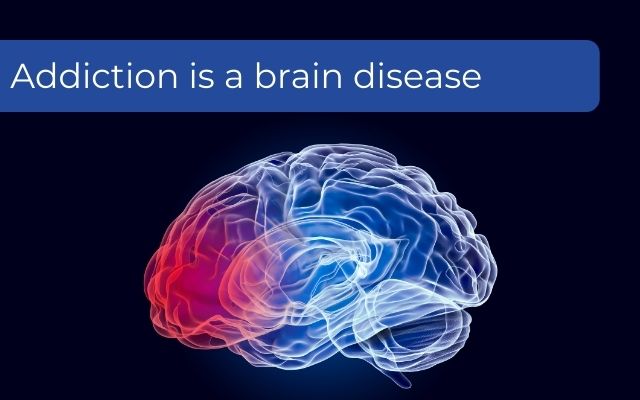Official definitions of addiction describe it as a brain disease and, importantly, not a choice. It may come as relief to many people who are stuck in the terrifying cycle of addiction that they have a medical condition and are not necessarily weak or bad people.
But how exactly does addiction manifest in the brain and the way it functions? Read on to understand what happens in the brain when it comes to substance abuse and dependency.
Definition of addiction
Official definitions of addiction foreground the fact that it is not a choice or moral failing but a medical condition or brain disease.
The American Society of Addiction Medicine defines addiction as a “treatable, chronic medical disease involving complex interactions among brain circuits, genetics, the environment, and an individual’s life experiences”.
The United States’ National Institute on Drug Abuse (NIDA) adds that addiction is “a chronic, relapsing disorder characterized by compulsive drug seeking, continued use despite harmful consequences, and long-lasting changes in the brain”.
According to NIDA, addiction is considered to be a complex brain disorder and mental illness that is caused by repeated misuse of substances.
Addicted individuals may have “distorted” thinking and behaviours notes the American Psychiatric Association on its website. “Changes in the brain’s structure and function are what cause people to have intense cravings, changes in personality, abnormal movements, and other behaviors,” explains the Association. “Brain imaging studies [about people with addiction] show changes in the areas of the brain that relate to judgment, decision making, learning, memory, and behavioral control.”
Addiction and the brain’s reward system
But how exactly does this disease work when it comes to the brain?
Some people are more susceptible to developing an addiction than others due to a complex interplay between genetics, other medical conditions and environmental factors. But anyone who abuses substances repeatedly is at risk of becoming dependent on drugs or alcohol.
This is because repeated substance abuse affects the way the brain’s reward system functions.
It also affects motivation and memory causing a person’s internal motivation system to malfunction to the extent that addictive behaviours, like repeated substance use, replace the original motivations that prompt healthy behaviours.
Our brains have evolved over the millennia to enable and motivate us to discover new and healthy things by rewarding us through the release of the ‘pleasure’ neurotransmitter dopamine. This encourages us to remember the behaviour (for example, eating when hungry) and to repeatedly pursue it in order to repeat the release of dopamine in the brain.
A helpful way to think of the effect of addiction on the brain is that drugs of abuse ‘hijack’ this reward system. These substances artificially elicit this dopamine response more intensely than natural rewards. To the individual using the drugs or alcohol, this flood of dopamine is experienced as the ‘high’. This tricks the brain into thinking that using these substances is a positive thing, motivating a person to use again and again to repeat the experience of a high.
The brain learns to associate the drug use with pleasure. But the body usually builds up a tolerance to the specific drug which leads to higher and more frequent drug use to achieve the same high.
Unlike with healthy behaviours, like eating or having sex, where the dopamine response ends once the behaviour has been carried out, with drugs this response continues long after the substance is consumed. This leads to cravings and compulsive and repetitive drug or alcohol use.
Changes in brain structure
Long-term drug abuse leads to structural changes in the brain. To compensate for the raised dopamine levels, the brain reduces the number of dopamine receptors.
Research has found that a reduction in dopamine receptors is linked to a rise in impulsive behaviour including a rapid escalation of drug use.
Another consequence of a reduction in dopamine receptors is that it becomes more difficult for a person to experience pleasure, even in once highly enjoyable activities. This can also prompt an individual to ramp up their drug use in an effort to feel pleasure and escape from depressive feelings.
Long-term drug use also starts to erode grey matter in the brain’s prefrontal cortex. The prefrontal cortex is an area in the brain that plays a key role in executive functioning including cognitive control functions, personality expression, decision making and moderating social behaviour. Dopamine in this area of the brain influences attention and impulse control.
The reduction in grey matter in the prefrontal cortex reduces an individual’s self-control as well as their ability to logically consider the negative consequences of their drug or alcohol abuse. It also leads to a reduction in the ability of the prefrontal cortex to regulate the brain’s reward system.
Even short-term substance abuse can affect brain structure, especially in young people.
Research shows that adolescence is an important time for brain development and adolescents who binge drink risk disrupting this growth with long-term consequences.
Both grey matter volume and grey matter thickness appear to decrease in young people who binge drink. This reduction in grey matter can diminish the brain’s response to risky decision making – which could lead to greater impulsivity and risk taking.
Why do some people become addicted and others do not?
According to the Global Commission on Drug Policy 2017, in 2016 an estimated quarter of a billion people aged between 15 and 64 years – about 5% of the global adult population – used an illegal drug. However, only about 11% of these people were considered to be problematic users or suffer from an addiction.
Moreover, about 10% of recreational marijuana users become addicted to the drug. Similarly, about one in 10 people who misuse prescription opioids become addicted to them.
Experts don’t fully understand why some people who abuse substances begin to use more, and more often, eventually progressing to develop an addiction while others do not.
It is thought to come down to a complex interplay between genetics, environmental factors, past experiences and mental health.
Abusing substances in childhood or adolescence makes a person more susceptible to developing an addiction because the brain is not yet fully developed at this life stage.
Are structural changes in the brain permanent?
The structural changes in the brain of those with an addiction persist long after a person stops using drugs or alcohol which cause cravings as well as put an individual at risk for relapse.
Some changes are permanent while others may not be. The exact nature of the permanence of these brain changes is still unknown.
According to NIDA some brain damage to the dopamine-based reward system appears to be, at least partly, reversable after some months of abstinence.
The brain is considered a resilient organ that is able to heal and grow over time – in line with a concept known as neuroplasticity. This gives hope to many addicts and alcoholics as they begin the process of recovery.
The longer a person remains abstinent the more time the brain has to heal and the less likely they are to return to drugs and the cycle of addiction.

Why it’s important to call addiction a disease
It is important to see addiction as a brain disease and a public health problem so that people receive much-needed treatment instead of counter-productive punishment.
Jail time does not help people but rehabilitative treatment does.
Thinking about addiction as a disease, and not as a behavioural choice, reduces the stigma surrounding the condition. It has encouraged countless people to seek help in the form of treatment who would have otherwise kept their drug use a secret, believing they were morally deficient instead of simply sick.
This disease model does not absolve people from taking responsibility for their behaviour. Recovery is a hard work and, once an addict or alcoholic gets help and manages to quit, they need to make a choice to stay clean every day. But it is important that they know that once they start using, they will be unable to stop on their own and that that is not their fault.
